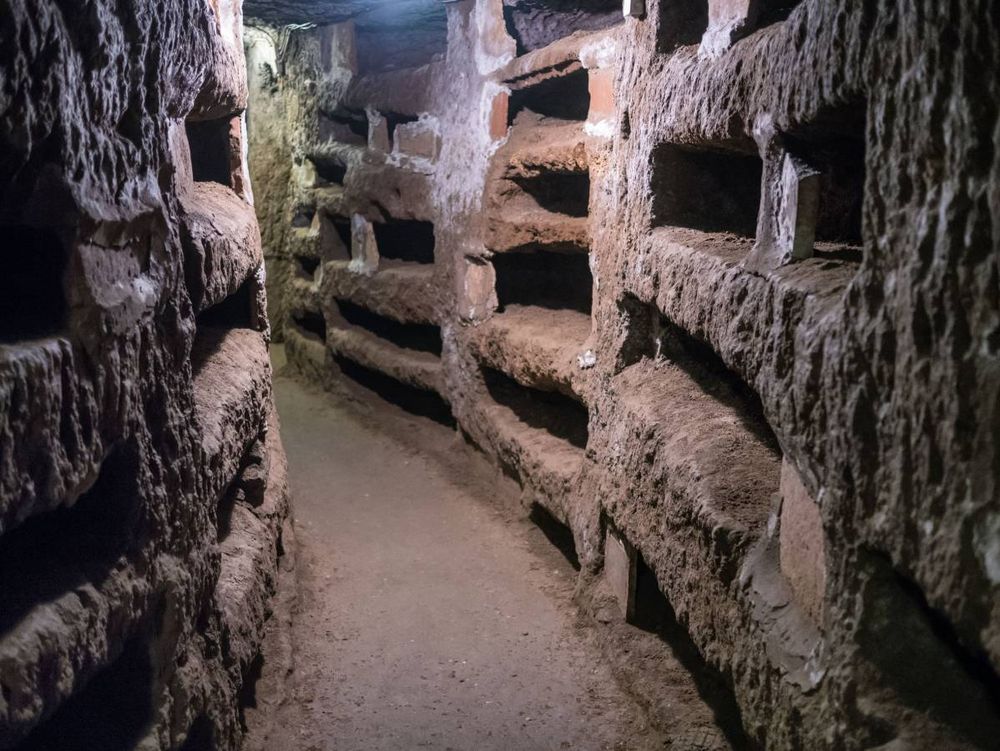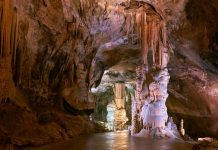The catacombs are made up of underground tunnels in the form of a labyrinth. They can reach the total number of many miles In the tufaceous walls of this intricate system of galleries were cut out rows of rectangular niches, calledloculi, of various dimensions, which could contain only one body, but not infrequently the remains of more than one person. The burials of the early Christians were extremely poor and simple.
The corpses, in imitation of Christ, were wrapped in a sheet or shroud and placed in the loculi without any kind of coffin.The loculi were closed with a slab of marble or, in most cases, by tiles fixed by mortar. On the tombstone the name of the deceased was sometimes engraved, along with a Christian symbol or a wish that the person might find peace in heaven. Oil lamps and small vases containing perfumes would often be placed beside the tombs.
The structure of the tombs, arranged in rows superimposed one upon another at different levels, gave one the idea of a vast dormitory, called cemetery, a term coming from Greek and meaning resting place. In this way the Christians wanted to affirm their faith in the resurrection of the bodies.
There were, besides the loculi, other types of tombs down in the catacombs: the arcosolium, the sarcophagus, the forma, the cubiculum and the crypt.
The arcosolium, a tomb typical of the third and of the fourth century, is a much larger niche with an arch above it. The marble-tomb covering was placed horizontally. They usually served as the burial chamber for entire families.
The sarcophagusis a stone- or marble-coffin, usually adorned with sculptured reliefs or inscriptions.
The formais a tomb dug into the floor of a crypt, of a cubiculum or of a gallery. They were very numerous near the martyrs’ tombs.
The cubicula(meaning bedrooms) were small rooms, truly family tombs, with a capacity of several loculi. The use of a family tomb was not a privilege reserved to the rich. The cubicles and the arcosoliums were frequently decorated with frescoes portraying biblical scenes and reproducing the themes of Baptism, Eucharist and Resurrection symbolized by the cycle of Jona.
The Cryptis a bigger room. Under Pope Damasus, many of the martyrs’ tombs were converted into crypts, that is into small underground churches embellished with paintings, mosaics or other decorations.
work of a specialized guild of workers called fossores (gravediggers).They dug gallery after gallery by the faint light of their lamps and used baskets or bags to carry the earth away, also through the lucemaria (sky-lights) opened in the vault of a crypt or of a cubicle or along the galleries. The lucemaria were ample shafts which reached the surface. When the work of excavation was finished, they remained opened as a vent for air and light, as a means of ventilation and lighting.
The ancient Christians did not use the termcatacomb. This is a word of Greek origin, meaning near the hollow. The Romans applied it to a locality on the Appian Way, where there were caves for the removal of tuff blocks. Nearby were dug the catacombs of Saint Sebastian. In the ninth century the term was extended to all cemeteries, with the specific sense of underground cemetery.












